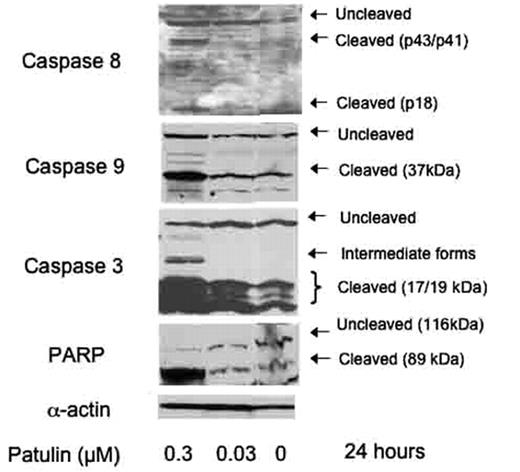Abstract
Background: Patulin (4-Hydroxy-4H-furo 3,2-C-pyran-2(6H)-one) is a mycotoxin produced by various species of fungi. Previous literature reports have suggested that Patulin is toxic to the immune system and is believed to kill T cells by covalently bonding to intermediates in the p38 map kinase pathway. We hypothesized that Patulin may have selective cytotoxicity against T-cell and B-cell malignancies.
Method: The cytotoxicity of Patulin was tested against normal peripheral blood mononuclear cells, malignant hematopoietic cell lines and primary leukemia cells. Malignant and normal mononuclear cells were incubated with serial dilutions of Patulin for 24 hours. Growth inhibition was assessed using an MTT assay and cytotoxicity and apoptosis was measured using flow cytometry following staining with 7AAD and annexin V. The concentration producing half maximal cytotoxicity (IC50) was determined for each target cell population. To further examine on the mechanisms responsible for the cytotoxic effect of Patulin, caspase pathway activation was examined by Western blot analysis.
Results: Twelve leukemia/lymphoma cell lines, 8 samples of blood containing primary leukemia and lymphoma, and mononuclear cells from 9 normal donors were tested. Patulin induced cell death of normal and malignant hematopoietic cells in a dose-dependent manner at micromolar concerntrations. The T-cell H9 cell line is > 100 times more sensitive to Patulin than normal T cells (IC50, 0.5μM vs. >50μM). The IC50 of other cell lines can be found in the Table. Annexin-V positivity, indicating apoptosis, was seen in 15%, 70% and 90% of H9 cells exposed to Patulin 0.3, 1.6 and 32μM 24hours, respectively. The fractions of viable primary tumor cell were also markedly reduced after treatment, with IC50 between 0.3 to 2.3 for acute lymphoblastic/myeloid leukemia. As shown in the Fig, western blotting of cell extracts from patulin-treated H9 cells revealed that treatment with Patulin for 24 hours results in activation of caspase-8, -9 and -3 into cleaved forms. PARP, the substrate of caspase-3, was significantly degradated after Patuin treatment.
Conclusion: Our findings suggest that Patulin can kill primary leukemia and leukemia cell lines by triggering apoptosis and by activating both intrinsic and extrinsic caspase pathways. The selective cytotoxicity of Patulin on T/B-cell malignant cell lines and primary leukemia cells suggests potential therapeutic activity in acute lymphoblastic leukemia/lymphoma.
Figure
Patulin IC50 of leukemia/lymphoma cell lines and primary tumor cells
| IC50 (μM) for mallignant cell lines | |||||||
| T-cell | Jurkat | MJ G11 | H9 | HH | HUT78 | Average | |
| 2.2 | 7.6 | 0.5 | 0.9 | 1.2 | 2.5 | ||
| B-cell | Daudi | Ramos | JVM2 | GRANTA519 | |||
| 1.5 | 1.8 | 1.5 | 7.0 | 3.0 | |||
| Myeloid | HL60 | KG1 | K562 | ||||
| 1.8 | 2.4 | 13 | 5.7 | ||||
| IC50 (μM) for primary leukemia/lymphoma cells | |||||||
| T-ALL | B-ALL | Mantle cell lymphoma | AML | ||||
| Pt 001 | Pt006 | Pt 005 | Pt014 | Pt002 | Pt004 | Pt007 | Pt009 |
| 2.3 | 0.5 | 0.3 | 0.4 | 6.0 | 1.0 | 0.4 | 0.3 |
| IC50 (μM) for T-cells from normal donors | |||||||
| CD3+ (n=9) | >50 | ||||||
| IC50 (μM) for mallignant cell lines | |||||||
| T-cell | Jurkat | MJ G11 | H9 | HH | HUT78 | Average | |
| 2.2 | 7.6 | 0.5 | 0.9 | 1.2 | 2.5 | ||
| B-cell | Daudi | Ramos | JVM2 | GRANTA519 | |||
| 1.5 | 1.8 | 1.5 | 7.0 | 3.0 | |||
| Myeloid | HL60 | KG1 | K562 | ||||
| 1.8 | 2.4 | 13 | 5.7 | ||||
| IC50 (μM) for primary leukemia/lymphoma cells | |||||||
| T-ALL | B-ALL | Mantle cell lymphoma | AML | ||||
| Pt 001 | Pt006 | Pt 005 | Pt014 | Pt002 | Pt004 | Pt007 | Pt009 |
| 2.3 | 0.5 | 0.3 | 0.4 | 6.0 | 1.0 | 0.4 | 0.3 |
| IC50 (μM) for T-cells from normal donors | |||||||
| CD3+ (n=9) | >50 | ||||||
Author notes
Disclosure: No relevant conflicts of interest to declare.


